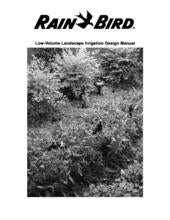Landscape Drip Design Guides
Low-Volume Landscape Irrigation Design Manual
Low-volume irrigation is simply a method of distributing water to plants. Like conventional overhead systems, a low-volume system requires proper design, installation, and ongoing maintenance. The most important benefit of low-volume irrigation is its potential to reduce or eliminate water waste. Using low-volume irrigation, you can match the water application to the specific needs of each plant.
Landscape Drip Application Guide
The Rain Bird’s low volume irrigation products were coined with the phrase “Xerigation” in the 1990’s and include drip irrigation and low volume spray products. The Rain Bird Xerigation system is the most efficient way to water landscapes. With over 150 products, Rain Bird has the products needed for your application. Systems can be designed to meet any site requirements and offer many exclusive Rain Bird advances
Landscape Drip Conversion GuideThis 4 page reference shows you the easiest and fastest way to convert a traditional spray zone into a water-efficient low volume irrigation zone. Includes step by step instructions for installing spray-to-drip retrofit kits, along with typical applications for converting narrow planting beds near a structure. |
XF Dripline Design, Installation and Maintenance Guide
This guide covers the basics of design, installation, and maintenance for Rain Bird’s XF Series Dripline. Included are design steps, technical data, installation layouts and design details to assist in the design of the more common dripline applications. Use of dripline is a preferred method in many low-volume irrigation applications. Rain Bird’s XF Series Dripline has Rain Bird designed and manufactured emitters that provide pressure compensation for precise flow control throughout the zone
Extra Durable Drip System Design Guide
Drip products can provide the most water-efficient irrigation solution. A successful outcome requires careful consideration. Rain Bird’s Extra Durable Drip System should be considered for high impact commercial sites where durability, longevity, ease of maintenance and minimal plant failure rate are the top priorities





